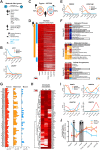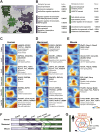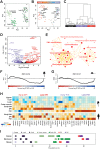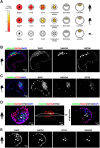Single cell transcriptome analysis of human, marmoset and mouse embryos reveals common and divergent features of preimplantation development
- PMID: 30413530
- PMCID: PMC6240320
- DOI: 10.1242/dev.167833
Single cell transcriptome analysis of human, marmoset and mouse embryos reveals common and divergent features of preimplantation development
Abstract
The mouse embryo is the canonical model for mammalian preimplantation development. Recent advances in single cell profiling allow detailed analysis of embryogenesis in other eutherian species, including human, to distinguish conserved from divergent regulatory programs and signalling pathways in the rodent paradigm. Here, we identify and compare transcriptional features of human, marmoset and mouse embryos by single cell RNA-seq. Zygotic genome activation correlates with the presence of polycomb repressive complexes in all three species, while ribosome biogenesis emerges as a predominant attribute in primate embryos, supporting prolonged translation of maternally deposited RNAs. We find that transposable element expression signatures are species, stage and lineage specific. The pluripotency network in the primate epiblast lacks certain regulators that are operative in mouse, but encompasses WNT components and genes associated with trophoblast specification. Sequential activation of GATA6, SOX17 and GATA4 markers of primitive endoderm identity is conserved in primates. Unexpectedly, OTX2 is also associated with primitive endoderm specification in human and non-human primate blastocysts. Our cross-species analysis demarcates both conserved and primate-specific features of preimplantation development, and underscores the molecular adaptability of early mammalian embryogenesis.
Keywords: Blastocyst; Embryo; Human; Inner cell mass; Pluripotency; Primate.
© 2018. Published by The Company of Biologists Ltd.
Conflict of interest statement
Competing interestsThe authors declare no competing or financial interests.
Figures







References
-
- Acampora D., Omodei D., Petrosino G., Garofalo A., Savarese M., Nigro V., Di Giovannantonio L. G., Mercadante V. and Simeone A. (2016). Loss of the Otx2-binding site in the Nanog promoter affects the integrity of embryonic stem cell subtypes and specification of inner cell mass-derived epiblast. Cell Rep. 15, 2651-2664. 10.1016/j.celrep.2016.05.041 - DOI - PubMed
-
- Akagi T., Kuure S., Uranishi K., Koide H., Costantini F. and Yokota T. (2015). ETS-related transcription factors ETV4 and ETV5 are involved in proliferation and induction of differentiation-associated genes in embryonic stem (ES) cells. J. Biol. Chem. 290, 22460-22473. 10.1074/jbc.M115.675595 - DOI - PMC - PubMed
Publication types
MeSH terms
Substances
Grants and funding
LinkOut - more resources
Full Text Sources
Other Literature Sources
Molecular Biology Databases

